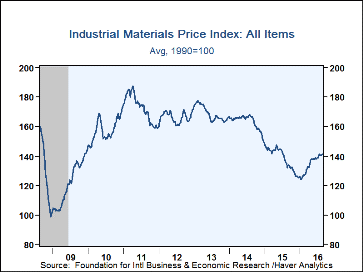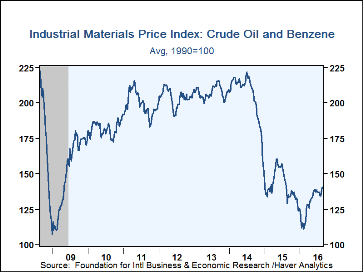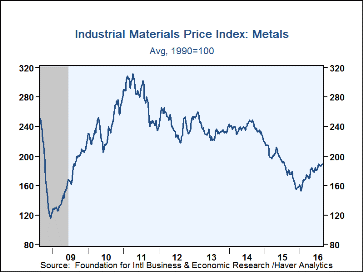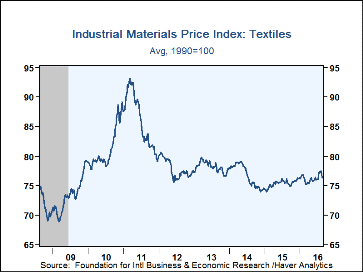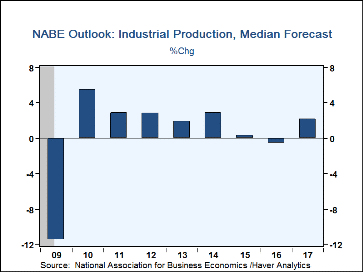 Global| Aug 19 2016
Global| Aug 19 2016FIBER: Industrial Commodity Prices Improve
by:Tom Moeller
|in:Economy in Brief
Summary
Prices in the industrial sector are drawing support from the improvement in factory sector activity. Since December, manufacturing sector production has risen 0.6% following last year's 0.3% decline from December-to-December. That [...]
Prices in the industrial sector are drawing support from the improvement in factory sector activity. Since December, manufacturing sector production has risen 0.6% following last year's 0.3% decline from December-to-December. That improvement has given life to industrial commodity prices. The Industrial Materials Price Index from the Foundation for International Business and Economic Research (FIBER) eased 0.1% during the last four weeks, but remained up 1.9% during the last three months. A 4.8% increase in prices during the last twelve months follows sharp declines from 2012 to 2015.
Within the sector groupings of prices, the FIBER indexes showed increases in several categories. Prices were strong in the crude oil & benzene area. Including its recent spike to near $50 per barrel, the cost of WTI crude oil has roughly doubled from its February low. Prices for the petro-chemical benzene have risen by one-third since February. In the miscellaneous group, home building improvement raised framing lumber prices 4.8% last month and by 13.2% y/y. Prices for structural panels also gained 13.9% y/y. Natural rubber prices recovered by roughly one-third so far this year, following sharp declines since the 2011 high. Within the metals sector, pricing remained uneven. Aluminum prices improved 8.9% during the last three months and were 8.7% higher over the last year. Copper scrap prices moved 3.1% higher during the last three months, but were down 5.8% y/y. Steel scrap prices remained under pressure. A 15.1% decline during the last three months left them off 0.6% y/y. In the textile group, cotton prices declined 6.3% last month but were 4.5% higher versus last year. Burlap prices, however, were down by 3.0% m/m, and were off 4.0% y/y.
Over the near term, there may be further support coming for commodity prices. The current industrial output projection from the National Association for Business Economics (NABE) calls for a 0.6% decline in industrial production during all of 2016. That suggests that recent improvement in factory sector activity must be sustained to limit this year's overall weakness. The pricing environment next year may continue its recent improvement as factory output is expected to increase 2.2% during all of 2017. During the last ten years, there has been a 52% correlation between the three-month change in prices and the change in industrial output.
Commodity price data can be found in Haver's DAILY, WEEKLY, USECON and CMDTY databases. The NABE forecast is in the SURVEYS database.
| FIBER Industrial Materials Price Index (1990=100) | 1-Mth % | 3-Mth % | 6-Mth % | 12-Mth % | 2015 % | 2014 % | 2013 % |
|---|---|---|---|---|---|---|---|
| All Items | -0.1 | 1.9 | 11.1 | 4.8 | -16.3 | -10.0 | -2.9 |
| Textiles | -1.3 | 0.6 | 0.2 | 0.2 | 2.2 | -4.2 | 0.4 |
| Cotton (cents per pound) | -6.3 | 11.9 | 15.3 | 4.5 | 2.6 | -24.2 | 10.8 |
| Metals | 0.4 | 4.8 | 12.6 | 5.5 | -27.8 | -8.7 | -3.5 |
| Aluminum ($ per metric ton) | 1.9 | 8.9 | 9.9 | 8.7 | -19.2 | 9.4 | -15.8 |
| Copper Scrap (cents per pound) | -3.0 | 3.1 | 4.7 | -5.8 | -27.0 | -12.0 | -6.8 |
| Steel Scrap ($ per ton) | 1.6 | -15.1 | 25.1 | -0.6 | -53.8 | -18.6 | 8.4 |
| Crude Oil & Benzene | 2.7 | 3.2 | 24.3 | 2.7 | -19.4 | -26.5 | 0.8 |
| Crude Oil (WTI, $ per Barrel) | 2.3 | -3.4 | 53.6 | 11.6 | -35.8 | -43.2 | 10.3 |
| Miscellaneous | -0.8 | -0.3 | 13.3 | 8.9 | -18.0 | -6.7 | -6.8 |
| Framing Lumber ($ per 1000 board ft.) | 4.8 | 2.8 | 17.9 | 13.2 | -16.4 | -1.6 | 3.5 |
| Natural Rubber (cents per pound) | 7.4 | -2.8 | 30.3 | 19.5 | -22.5 | -32.3 | -9.8 |
Tom Moeller
AuthorMore in Author Profile »Prior to joining Haver Analytics in 2000, Mr. Moeller worked as the Economist at Chancellor Capital Management from 1985 to 1999. There, he developed comprehensive economic forecasts and interpreted economic data for equity and fixed income portfolio managers. Also at Chancellor, Mr. Moeller worked as an equity analyst and was responsible for researching and rating companies in the economically sensitive automobile and housing industries for investment in Chancellor’s equity portfolio. Prior to joining Chancellor, Mr. Moeller was an Economist at Citibank from 1979 to 1984. He also analyzed pricing behavior in the metals industry for the Council on Wage and Price Stability in Washington, D.C. In 1999, Mr. Moeller received the award for most accurate forecast from the Forecasters' Club of New York. From 1990 to 1992 he was President of the New York Association for Business Economists. Mr. Moeller earned an M.B.A. in Finance from Fordham University, where he graduated in 1987. He holds a Bachelor of Arts in Economics from George Washington University.


